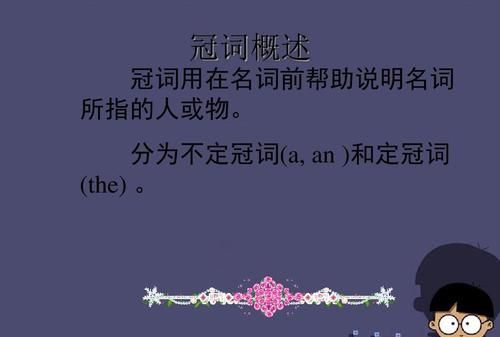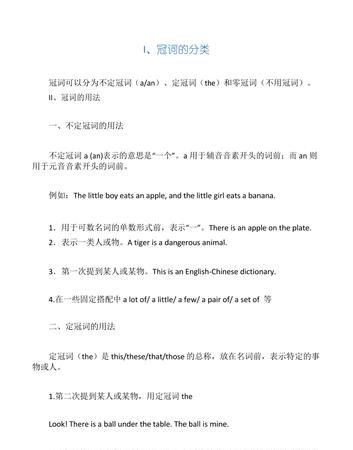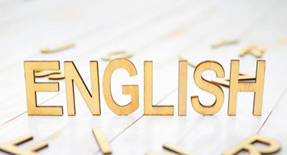本文目录
英语什么情况需要加to
仅供参考:
一、定冠词the_
1.定冠词the和一个形容词连用,代表一类人.若其作主语,则其后的谓语动词用复数形式.
2.由普通名词和另外一些词构成的专有名词前多数要加定冠词
3) 某些节假日前:the Spring Festival春节,the Mid-Autumn Day中秋节
但也有一些这类专有名词前不加定冠词
3.一些乐器名称前面通常用the,如play the guitar,play the piano.但在一些特殊的表达中不用the,如with Kenney Rogers on saxophone,with Miles Davis on trumpet.体育比赛的项目前也不加定冠词,如play chess,play volleyball / basketball.
4.一年四季spring,summer,autumn /fall,winter 前,可用亦可不用定冠词,意思基本一样,但在美语中,通常为in the fall
5.物质名词前一般不加定冠词,但当一些物质名词不用于一般意义,而表示该物质的特定部分,特别是当其有限制性定语时,常加定冠词
二、不定冠词a(an)
1.what 后的感叹句中,若感叹的名词是可数名词单数,不定冠词a/an不能省略.如:
What a horrible day!
2.a/an 用于指非独一无二的工作或职业
3.疾病名称通常被认为是不可数的,因此,其前通常不加冠词
.习惯用定冠词的表达
by the way,on the whole,in the end,on the way to,tell the truth,on the right / left,in the possession of,be in the habit of doing sth.,on the spot,the day before yesterday,in the distance,in the case of,for the time being,at the hands of,in the front of,be in the dark,at the back of,to the extent of等.
2.习惯用不定冠词的表达
as a matter of fact,as a rule,be in a position to,a matter of course,all of a sudden,be at a loss,have a chance,have a good time,have a hand in,have a say,have a try,keep an eye on,on a large scale,with a firm hand,take a fancy to,be in a hurry,take a walk,take an interest in等.
3.习惯用零冠词的表达
at noon/night/dawn/midnight,in town,in front of,at bottom,in order,in peace,at hand,at home,at last,at present,at stake,at war,by way of,day and night,without result,on top of,in trouble,in sight,from beginning to end,in advance,in haste,in danger,in case(of),in possession of,in fashion,in fact,take part in,take place等.

冠词在英语中表示什么
不定冠词(例如英语中的a/an)用来表示这个冠词后面的名词是指某一类特定事物中的一个,但具体是哪一个并不重要;
其中a用于辅音音素前 。例如:
a useful book,
a university,
have a swim/walk/talk/look/dance/drink/rest ,
a European......
而an则用于元音音素前。例如:
an hour,
an honest boy ,
keep an eye on sth
2、定冠词(例如英语中的the)用来限定这个冠词后面的名词是某个特定的事物,定冠词的用法规则则比较多,包含以下几条:
1)特指双方都明白的人或物:
Give me the book.
2)上文提到过的人或事:
--Do you know the lady in blue?
–Yes, she is a teacher of a university.
3)指世上独一物二的事物
the sun ( sky / moon/ earth/ world/ nature/ universe )
4)单数名词连用表示一类事物;或与形容词或分词连用,表示一类人:
the dollar 美元; The lion is a wild animal.
the rich /poor/ blind/ aged / living / impossible
5)用在序数词和形容词最高级,形容词only,very, same,表示身体部位的名词等前面:
I live on the second floor.
She caught me by the arm.
6)用在表示乐器和表方位的名词前:
She plays the piano \violin \ guitar in the north of China
7)用在普通名词构成专有名词前:
the People's Republic of China the United States the Great Wall the Summer Palace
7)用在姓氏的复数名词之前,表示一家人:
the Greens are playing the piano.
8)其他一些固定用法:
in the day,
in the morning,
in the middle(of)
in the end,
all the time at the same time on the whole,
by the way
the next morning,
in the sky(water,field,country)
in the dark,in the rain......
扩展资料:
没有单一规则可用来确定使用或不用冠词a、an、the。
对于是否要使用冠词,在某些情况下,只有一个正确的选择,而在另一些情况下,不同的冠词用法可以改变句子的意义。
所有英语名词可归为两大类:可数名词和不可数名词。
一个名词是属于可数名词还是不可数名词,这要看它在句子中的意思来决定,即是否在数量上可以“一个个独立地数出来”。
例如,在句子“She has long hair.”中(她长着长头发),“hair”是不可数名词。然而,在句子“There’s a hair in my soup.”中(我的汤里有一根头发),“hair”是可数名词。
再来看一个句子:“I ate a cake”表示我吃了“整个”蛋糕──这不太可能,通常情况下蛋糕比较大;所以,正确的说法应该是“I ate cake”(cake前面去掉冠词a),即表示我吃了“一些”(一部分)蛋糕。
名词前面有冠词“a”说明该名词是可数的,所谈论的是一个完整的东西,即整个东西。如果去掉前面的冠词“a”,则表示后面的名词是不可数的,所谈论的是一部分或一定量的某样东西。
用法要点:根据名词是否具有可数或不可数的意义,相应地使用或不用冠词“a”(包括an)。
参考资料:
百度百科-冠词

冠词的存在有什么意义
冠词的最主要的意义还是在表示界定和范围上。是表示特指还是特指,比如英语中的a和an。就表示一个,但具体哪一个并不指明。但the就表示特指的某样东西,谈话双方都知道的。冠词的意义总的来讲还是方便两者之间的交流。但说实话,例如法语中的Le,la。德语中的Dec,As ,Die。意大利语中的Ali,la,Le等等,只是根据名词不同的性和数来进行搭配。
需要死记硬背。例:(1)I don't like cheese.(2)I like the cake, but I don't like the cheese.(1)我不喜欢奶酪。(2)我喜欢这块蛋糕,但是我不喜欢里面的奶酪。(1)不加冠词,cheese指向了奶酪这一大类;(2)加了定冠词the,说话者将cheese锁定在了这一块蛋糕里的奶酪,只对这块奶酪表达了喜好。

冠词在英语中起到了什么作用 为什么要有冠词表示
定冠词
和不定
冠词
还有名词复数
都可以表示类别
如下面三句话
意思是一样的:
the
horse
is
a
useful
animal.
a
horse
is
a
useful
animal.
horses
are
useful
animals.
定冠词表类别
强调
特性
不定冠词表类别强调
一般性
普遍性。不管是特性还是普遍性
都是该类人和东西的本性。所以
一般情况下
选定冠词和不定冠词都对

以上就是关于英语中为什么要由冠词,英语什么情况需要加to的全部内容,以及英语中为什么要由冠词 的相关内容,希望能够帮到您。

